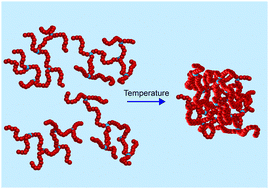Temperature-dependent structure and dynamics of highly-branched poly(N-isopropylacrylamide) in aqueous solution†
Abstract
Small-angle neutron scattering (SANS) and neutron spin-echo (NSE) have been used to investigate the temperature-dependent solution behaviour of highly-branched poly(N-isopropylacrylamide) (HB-PNIPAM). SANS experiments have shown that water is a good solvent for both HB-PNIPAM and a linear PNIPAM control at low temperatures where the small angle scattering is described by a single correlation length model. Increasing the temperature leads to a gradual collapse of HB-PNIPAM until above the lower critical solution temperature (LCST), at which point aggregation occurs, forming disperse spherical particles of up to 60 nm in diameter, independent of the degree of branching. However, SANS from linear PNIPAM above the LCST is described by a model that combines particulate structure and a contribution from solvated chains. NSE was used to study the internal and translational solution dynamics of HB-PNIPAM chains below the LCST. Internal HB-PNIPAM dynamics is described well by the Rouse model for non-entangled chains.



 Please wait while we load your content...
Please wait while we load your content...